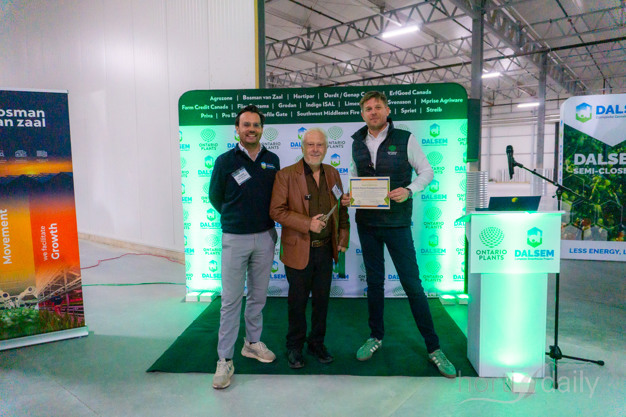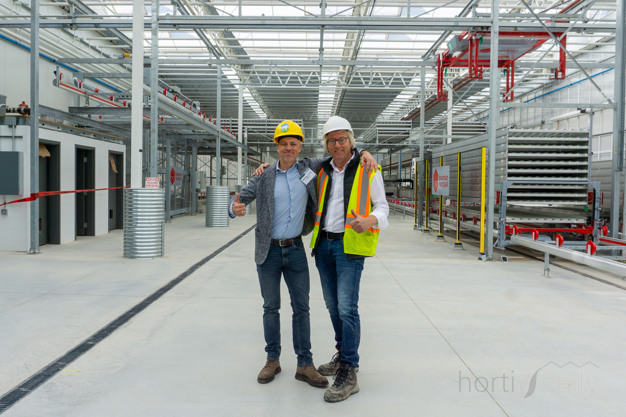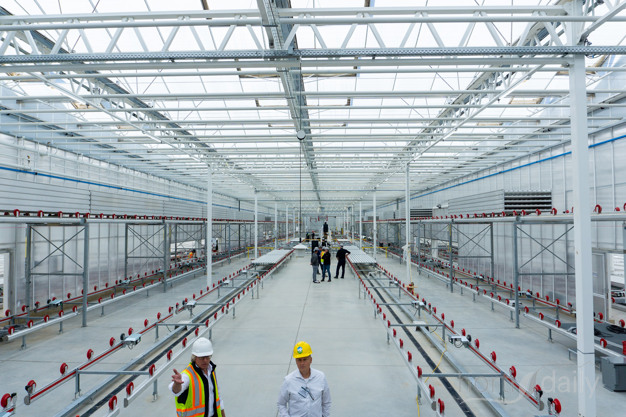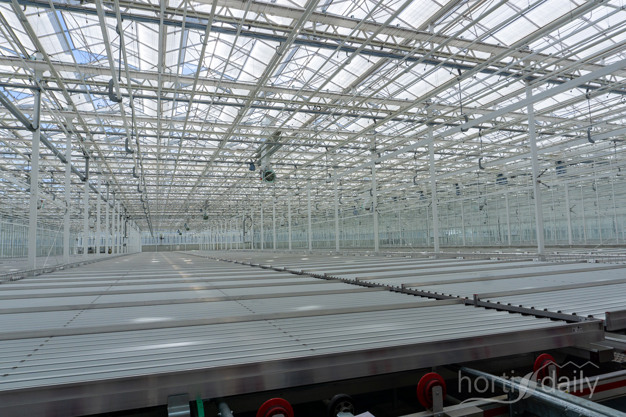Ontario Plants Propagation officially opened its 5-hectare greenhouse expansion in Glencoe on October 8th, 2024, in the presence of over 200 guests from the horticultural industry. The open house continues today, with many more visitors expected, as it is one of the most remarkable projects realized this year. The new propagation facility aims to set a new standard in biosecurity and plant quality, supported by high-level automation This greenhouse marks the beginning of a project that will eventually cover 20 hectares and include facilities for both seeding and grafting.

The ribbon-cutting ceremony was performed by Allan Mayhew, Mayor of Southwest Middlesex, who expressed his excitement about having Ontario Plants Propagation as part of the local community. He was joined by Mathieu van de Sande, CEO of Ontario Plants Propagation, and Frank van der Gelt, CEO of Dalsem.
This is the second facility for Ontario Plants Propagation, with the original located in St. Thomas, and the opening of the first phase in Glencoe also marks the beginning of a larger initiative. Three additional phases are planned, with the full expansion expected to significantly boost Ontario Plants Propagation's capacity. Once complete, the facility will more than double the company's annual output from 60 million plants to over 100 million, supplying high-quality vegetable and soft fruit plants to greenhouse operations across North America. Over the coming years, the St. Thomas facility will be redesigned to focus on the growing market for organic and soft fruit plants, while the new facility will concentrate on hydroponic plants grown in rock wool.

This development reflects the shifting landscape of North American horticulture, as more growers transition to controlled environment agriculture (CEA).
"As the CEA industry continues its shift from traditional outdoor farming to advanced indoor cultivation, the demand for high-tech, sustainable solutions is surging. Our expansion is designed to address these evolving market trends, providing cutting-edge support for greenhouse operators across the continent to meet growing food production needs," said Mathieu.
The new 5-hectare greenhouse is designed with hygiene and biosecurity as top priorities, ensuring optimal conditions for the propagation of young vegetable plants. To enhance both efficiency and safety, all plant handling and movement occur in a designated corridor outside the growing area. This layout ensures that plants remain undisturbed within the greenhouse itself, supporting cleaner production practices. Ample space is left for growers to walk through and check on the plants, while the automated tables move plants around, allowing handling to take place in the corridor. This fully automated system also enables the company to space plants in a controlled and efficient manner. Other biosecurity measures include boot scrubbers, safety-certified cleaning stations, and speed doors to maintain hygiene and prevent cross-contamination.


The over-pressurized greenhouse is built by Dalsem and utilizes their semi-closed Dalsem Air model. This system ensures optimal indoor conditions by allowing growers to mix air from inside the greenhouse with air from above the screens, and even outside air. The facility is equipped with insect screens instead of netting, a choice explained by Pieter van Dijk as addressing the actual pests in the area: thrips, whereas the often-used insect netting mainly addresses whitefly, which is not an issue in Glencoe. The facility is also equipped with a diffused screen and a light abatement screen. Combined with PAR sensors, the Svensson PARPerfect solution optimizes light levels inside the greenhouse. In addition, a 45-million-liter water retention pond will recycle over 90% of rainwater, and a six-acre rooftop solar scheme is planned to enhance sustainability.
The greenhouse will also be fitted with a hybrid lighting system provided by Signify. While the lights are not yet installed, they will be added after a deep cleaning of the facility, scheduled to ensure a clean start once the current open house ends. The facility is expected to be fully operational by December.
It is clear that automation and innovation is at the core of this new facility. In his welcoming speech, Mathieu emphasized the importance of working closely with partners, many of whom were present at the event. These partnerships have been essential in implementing the advanced technologies throughout the facility. "Through these innovations, particularly our automated systems that manage plant movement across the greenhouse, we are setting a new benchmark in plant propagation. This technology enhances the quality of our plants by ensuring a more controlled environment, while also improving biosecurity. By reducing labor demands and increasing oversight at every stage, we are able to maintain the highest standards of plant health and safety."
Check out the photos of the opening here
For more information:
Ontario Plants
www.ontarioplants.com
